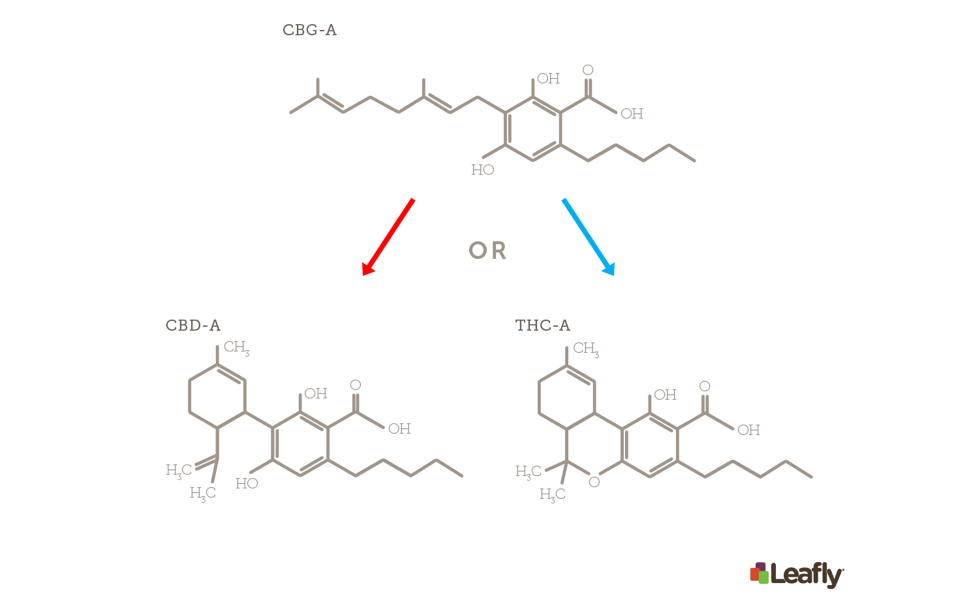What Is CBG (Cannabigerol) & What Does This Cannabinoid Do?
By now, most people familiar with cannabis have heard of THC (tetrahydrocannabinol) and CBD (cannabidiol) and their effects, but did you know there are many similar compounds in cannabis? A lesser-known cannabinoid called cannabigerol (CBG), while not present in large quantities in most strains, is nonetheless worth learning about for a number of reasons.
How Is CBG (Cannabigerol) Made?
Because it is present in low levels (usually less than 1%) in most cannabis strains, CBG is considered a minor cannabinoid. Amazingly, however, THC and CBD start out as CBG—it’s the chemical parent of THC and CBD (Figure 1). Cannabis plants produce cannabigerolic acid (CBGA), the precursor to the three main cannabinoid lines: tetrahydrocannabinolic acid (THCA), cannabidiolic acid (CBDA), and cannabichromenic acid (CBCA).

Specific enzymes in the plant break CBGA down and “direct” it toward one of the three lines. The acids are exposed to ultraviolet light or heat, and voila, they become the cannabinoids we know: THC and CBD. In most strains, CBGA is immediately converted to either THCA or CBDA. Thus, more THC means less CBG and CBD (and vice versa) by nature of how these compounds are synthesized.
To obtain higher yields of CBG, breeders are experimenting with genetic manipulation and cross-breeding of plants. For example, Subcool Seeds is crossing strains to produce higher CBG contents. Scientists can also extract higher levels of CBG from budding plants by pinpointing the optimum extraction time, about six weeks into an eight week flowering cycle. A medicinal strain called Bediol is produced in this fashion by the Dutch company Bedrocan BV Medicinal Cannabis.
CBG’s Potential Medical Benefits

The human body’s built-in endocannabinoid system (eCS) works to keep the body in its balanced state of homeostasis. While there are specific details about how cannabinoids work, in general the endocannabinoid system performs different functions specific to each area of the body. For example, at an injury site, the eCS can help regulate immune cells to limit inflammation.
CBG has been found to act on very specific physiological systems and problems, and results for medicinal use are promising:
- Endocannabinoid receptors are prevalent in eye structures, and interestingly, CBG is thought to be particularly effective in treating glaucoma because it reduces intraocular pressure. It is a powerful vasodilator and has neuroprotective effects to boot.
- In animal experiments involving mice, CBG was found to be effective in decreasing the inflammation characteristic of inflammatory bowel disease.
- In a recent 2015 study, CBG was shown to protect neurons in mice with Huntington’s disease, which is characterized by nerve cell degeneration in the brain.
- CBG is showing great promise as a cancer fighter. Specifically, CBG was shown to block receptors that cause cancer cell growth. In one such study, it was shown to inhibit the growth of colorectal cancer cells in mice, thereby slowing colon cancer growth. CBG inhibited tumors and chemically-induced colon carcinogenesis, therefore demonstrating a very exciting possibility for a cure for colorectal cancer.
- European research shows evidence that CBG is an effective antibacterial agent, particularly against methicillin-resistant Staphylococcus aureus (MRSA) microbial strains resistant to several classes of drugs. Since the 1950s, topical formulations of cannabis have been effective in skin infections, but researchers at the time were unaware of the plant’s chemical composition.
- In a very recent 2017 study, researchers showed that a form of CBG purified to remove delta-9 THC was a very effective appetite stimulant in rats. This may lead to a novel non-psychotropic therapeutic option for cachexia, the muscle wasting and severe weight loss seen in late stage cancer and other diseases.
- In a study that looked at the effects of five different cannabinoids on bladder contractions, CBG tested best at inhibiting muscle contractions, so it may be a future tool in preventing bladder dysfunction disorders.
Scientists are excited about these initial CBG results and are promoting future research with CBG alone or CBG in combination with other cannabinoids and therapies for the treatment of multiple maladies. Because it is non-psychotropic, CBG has a promising wide range of potential applications not only for the problems mentioned above, but also as an analgesic, therapy for psoriasis, and as an antidepressant.
